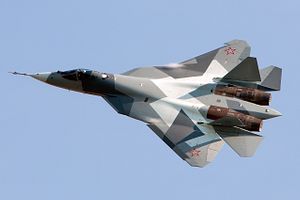A high-powered panel instated by the Indian Ministry of Defense, headed by retired Air Marshal Simhakutty Varthaman, in a new report purportedly recommends that India push ahead with one of the most high-profile joint India-Russia defense programs, the co-development and production of the the Sukhoi/HAL Fifth Generation Fighter Aircraft (FGFA), known in India as the Perspective Multirole Fighter (PMF), according to local media reports.
The Indian Ministry of Defense has so far not publicly commented on the content of the panel’s conclusions. “We were given a task and we have submitted our report to the government. That’s all I can tell you,” Varthaman told the Hindustan Times last week. The Indian Air Force has increasingly grown hostile to the program. As I reported earlier this year, among other things, a senior Indian Air Force official said that “an unaffordable price for the aircraft.”
India and Russia have so far failed to reach a work sharing agreement. Russia has reportedly been asking for $7 billion from India given that any future cooperation will include the transfer of sensitive Russian defense technology. Indeed, the transfer of sensitive technology from Russia to India has been one of the most serious points of contention right from the outset. As I explained in February:
Before moving on, India wants a guarantee that it will be able to upgrade the fighter jet in the future without Russian support, which would require Moscow sharing source codes (sensitive computer code that controls the fighter jet’s various systems — the key to an aircraft’s electronic brains). In addition, the FGFA should directly support India’s advanced medium combat aircraft (AMCA) program — a separate Indian fifth generation fighter project.
India and Russia began exploring the possibilities of a joint stealth fighter program in 2007. In 2010, both sides signed a $295 million design contract for the co-development of the FGFA/PMF. Yet disagreements over what technologies should to be used for the new aircraft, next to a host of other issues including a work and cost sharing plan, caused repeated delays. “After evaluating the first PAK FA T-50 prototype (the Russian prototype of the PMF), the Indian Air Force (IAF) wanted more than 40 changes addressing, among other things, perceived weaknesses in the plane’s engine, stealth, and weapon-carrying capabilities,” I explained previously.
Indian defense officials also remain skeptical whether Russia can develop a next-generation engine for the stealth fighter. Another major stumbling block remains the number of aircraft to be ordered:
Russia announced in late 2015 that it would only induct a squadron (18-24 aircraft) of PAK FA fighter aircraft, and procure additional Sukhoi Su-35 aircraft instead. The original deal involved Russia procuring 250 and India 144 aircraft at a cost of around $30 billion by 2022. As a result, India threatened to abandon the project in its entirety. Russia in turn made a number of concessions including an offer to cut down its financial contribution from $6 to $ 3.7 billion for three PAK FA T-50 prototypes and substantial technology transfers.
There is still no agreement on how many aircraft should be produced for the Indian Air Force if at all. It is noteworthy that Indian Defense Minister Arun Jaitley and his Russian counterpart Sergei Shoigu, while concluding a military cooperation roadmap in June, failed to resolve the ongoing dispute over the joint FGFA project.































